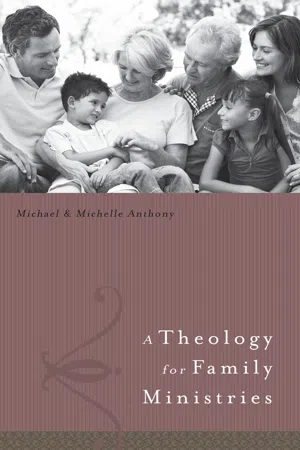
A Theology for Family Ministry
- 304 pages
- English
- ePUB (mobile friendly)
- Available on iOS & Android
A Theology for Family Ministry
About this book
The times are definitely changing. What was once simply referred to as a Nuclear Family in North America has morphed into labels such as Non- Traditional Families, Fragmented Families, Single-Parent Families, Gay- Partner Families, Blended Families, and beyond."It may not always be pretty, but it is reality, and that's the intersection between biblical ideal and ministry practice, " writes editor Michael J. Anthony in A Theology for Family Ministry. With thoroughly researched input from a broad team of family experts, the book advises church and ministry leaders on how to make biblically and philosophically informed choices when reaching out to adults and children within these shifting paradigms. Emphasis is placed on what the Scriptures teach about the composition of the home, followed by discerning and hope filled strategies for helping all families live out their God-given mandates. "While the family may continue to change into models that bring discom fort and angst to some of us, we rest in the assurance that God has a plan for those who live in any of these new configurations of what we now call family, " explains Anthony. Other contributors include Ken Canfield, Michelle D. Anthony, Karen E. Jones, Freddy Cardoza, Michael S. Lawson, Richard Melick Jr., Curt Hamner, Leon Blanchette, Gordon R. Coulter, James W. Thompson, Timothy Paul Jones, Randy Stinson, Kit Rae, and David Keehn.
Frequently asked questions
- Essential is ideal for learners and professionals who enjoy exploring a wide range of subjects. Access the Essential Library with 800,000+ trusted titles and best-sellers across business, personal growth, and the humanities. Includes unlimited reading time and Standard Read Aloud voice.
- Complete: Perfect for advanced learners and researchers needing full, unrestricted access. Unlock 1.4M+ books across hundreds of subjects, including academic and specialized titles. The Complete Plan also includes advanced features like Premium Read Aloud and Research Assistant.
Please note we cannot support devices running on iOS 13 and Android 7 or earlier. Learn more about using the app.
Information
North American Family

- About one out of six 15-year-old girls will give birth before reaching the age of 20, according to the National Center of Health Statistics.
- In 1950 women made up 28 percent of the workforce. Today that figure is 48 percent.
- Multigenerational families have increased by 60 percent since 1990, according to www.togetheragain.com.
- A new Census Bureau American Community Survey shows that the number of parents younger than age 65 in households was up 75 percent between 2000 and 2007. It would appear families are not putting their aging parents in nursing homes as frequently as before.
- In the early 1960s, almost 60 percent of families had children younger than 18 living at home; that percentage in 2009 had dropped to just 46 percent.
- Married couples are older now. In 1968 less than 30 percent of married men were 55 and older. Today, nearly 40 percent are that age; the percentage of married women 55 and older has increased from 22 percent to 33 percent.
- Twenty percent of women ages 40 to 44 have no children, double the level of 30 years ago; women who do have children in that age category have fewer of them—an average of 1.09 children today compared to 3.1 children in 1976.
- Of women who gave birth in 2006, 36 percent were separated, widowed, divorced, or never married. Five percent were living with a partner.
- Research indicates that a 10 percent increase in welfare benefits increases by 12 percent the chances that a poor young woman will have a baby out of wedlock before she reaches the age of 22. This is true for both black and white girls.
Table of contents
- Cover
- Title
- Copyright
- Dedication
- Contents
- Unit 1
- Chapter 1
- Chapter 2
- Chapter 3
- Unit 2
- Chapter 4
- Chapter 5
- Chapter 6
- Chapter 7
- Chapter 8
- Chapter 9
- Unit 3
- Chapter 10
- Chapter 11
- Chapter 12